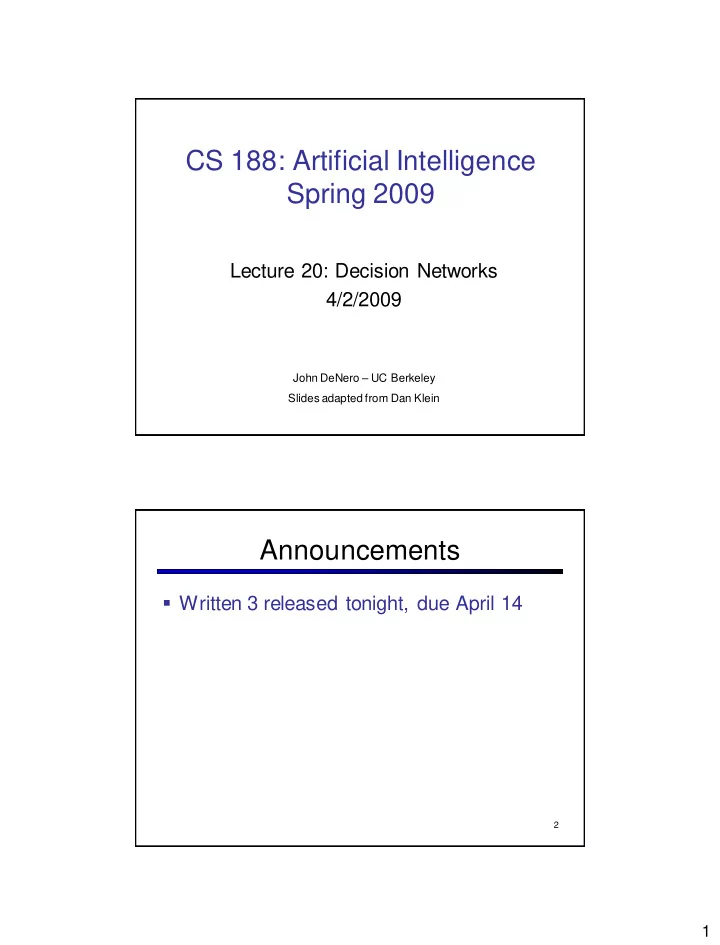

CS 188: Artificial Intelligence Spring 2009 Lecture 20: Decision Networks 4/2/2009 John DeNero – UC Berkeley Slides adapted from Dan Klein Announcements Written 3 released tonight, due April 14 2 1
Decision Networks MEU: choose the action which maximizes the expected utility Umbrella given the evidence U Can directly operationalize this with decision networks Bayes nets with nodes for Weather utility and actions Lets us calculate the expected utility for each action New node types: Chance nodes (just like BNs) Actions (rectangles, must be Forecast parents, act as observed evidence) Utility node (diamond, depends on action and chance nodes) 3 Decision Networks Action selection: Umbrella Instantiate all evidence Set action node(s) U each possible way Calculate posterior Weather for all parents of utility node, given the evidence Calculate expected utility for each Forecast action Choose maximizing action 4 2
Example: Decision Networks Umbrella = leave Umbrella U Weather Umbrella = take A W U(A,W) W P(W) leave sun 100 sun 0.7 leave rain 0 rain 0.3 take sun 20 Optimal decision = leave take rain 70 5 Evidence in Decision Networks Find P(W|F=bad) Umbrella Select for evidence U W P(W) W P(W) W P(F=bad|W) sun 0.7 sun 0.7 sun 0.2 rain 0.3 rain 0.9 rain 0.3 Weather F P(F|sun) First we join P(W) and good 0.8 P(bad|W) bad 0.2 Then we normalize F P(F|rain) Forecast good 0.1 W P(W | F=bad) W P(W,F=bad) bad 0.9 sun 0.34 sun 0.14 rain 0.66 rain 0.27 3
Example: Decision Networks W P(W|F=bad) Umbrella Umbrella = leave sun 0.34 rain 0.66 U Weather Umbrella = take A W U(A,W) leave sun 100 leave rain 0 take sun 20 Forecast take rain 70 =bad Optimal decision = take 7 [Demo] Conditioning on Action Nodes An action node can be a parent of a chance node A S Chance node conditions on the outcome of the action S’ U Action nodes are like observed variables in a T(s,a,s’) R(s,a,s’) Bayes’ net, except we max over their values 8 4
Value of Information Idea: compute value of acquiring each possible piece of evidence Can be done directly from decision network DrillLoc Example: buying oil drilling rights U Two blocks A and B, exactly one has oil, worth k Prior probabilities 0.5 each, & mutually exclusive OilLoc Drilling in either A or B has MEU = k/2 Fair price of drilling rights: k/2 D O U O P a a k Question: what’s the value of information a 1/2 a b 0 Value of knowing which of A or B has oil b 1/2 Value is expected gain in MEU from new info b a 0 Survey may say “oil in a” or “oil in b,” prob 0.5 each b b k If we know OilLoc, MEU is k (either way) Gain in MEU from knowing OilLoc? VPI(OilLoc) = k/2 Fair price of information: k/2 9 Value of Perfect Information Current evidence E=e, utility depends on S=s Potential new evidence E’: suppose we knew E’ = e’ BUT E’ is a random variable whose value is currently unknown , so: Must compute expected gain over all possible values (VPI = value of perfect information) 10 5
VPI Example: Weather MEU with no evidence Umbrella U MEU if forecast is bad Weather A W U leave sun 100 MEU if forecast is good leave rain 0 Forecast take sun 20 Forecast distribution take rain 70 F P(F) good 0.59 7.8 bad 0.41 11 VPI Example: Ghostbusters Joint Distribution Reminder: ghost his hidden, sensors are noisy T B G P(T,B,G) t b g 0.16 T: Top square is red B: Bottom square is red t b g 0.16 G: Ghost is in the top t b g 0.24 t b g 0.04 Sensor model: t b g 0.04 P( t | g ) = 0.8 t b g 0.24 P( t | g ) = 0.4 P( b | g) = 0.4 t b g 0.06 P( b | g ) = 0.8 t b g 0.06 [Demo] 6
VPI Example: Ghostbusters Joint Distribution Utility of bust is 2, no bust is 0 T B G P(T,B,G) Q1: What’s the value of knowing T if I know nothing? t b g 0.16 t b g 0.16 Q1’: E P(T) [MEU(t) – MEU()] t b g 0.24 Q2: What’s the value of knowing t b g 0.04 B if I already know that T is true t b g 0.04 (red)? t b g 0.24 Q2’: E P(B|t) [MEU(t,b) – MEU(t)] t b g 0.06 t b g 0.06 How low can the value of information ever be? [Demo] VPI Properties Nonnegative in expectation Nonadditive ---consider, e.g., obtaining E j twice Order-independent 14 7
Quick VPI Questions The soup of the day is either clam chowder or split pea, but you wouldn’t order either one. What’s the value of knowing which it is? If you have $10 to bet and odds are 3 to 1 that Berkeley will beat Stanford, what’s the value of knowing the outcome in advance, assuming you can make a fair bet for either Cal or Stanford? What if you are morally obligated not to bet against Cal, but you can refrain from betting? 15 8
Recommend
More recommend